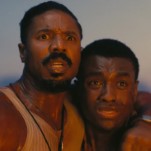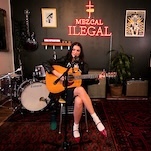Justice League

Justice League feels as if Zack Snyder has spent long hours in self-reflection, sucking up all of the criticism that’s been piled upon him for years—especially with his two most recent films establishing the DCEU—only to bury all of that negativity and failure and derisiveness deep, deep inside. The big phallic tentpole flick to finally tie DC’s Ed-Hardy-o-Verse together is a spectacle of overcompensation, and not of the toxic masculinity variety, though Snyder provides plenty of big phallic spaceships and big phallic laser beams piston-ing into the sky and plenty of chances for every member of the never-actually-named Justice League to awkwardly acknowledge how unbelievably hot Wonder Woman (Gal Gadot, Source of Light) is. No, Justice League just seems to exist to appease whomever Zack Snyder is obliged to appease, making up for everything bad he’s ever heard in passing about his movies by making a Zack Snyder movie as un-Snyder-ish as he can.
Which isn’t to say that Justice League is unrecognizable from Man of Steel or Batman v Superman, because there is still so much Snyder to behold here: egregious slo-mo; a fetid color palette subsuming an emo megalopolis; a plot that is somehow over- and underexplained, motivated by a CGI villain who looks like an anthropomorphic gall stone and whose powers are apocalyptic until they just aren’t; people holding important jobs like “journalist” or “art conservator” or “father raising his impoverished family in the brackish shadow of an abandoned Russian nuclear power plant” but who demonstrate not one ounce of proficiency in what they’re doing; yet another unforgivable Leonard Cohen cover; everyone just sort of flying everywhere. All of it is still very self-important, and still very tone-deaf.
The real difference between Justice League and Snyder’s previous DCEU entries is that the distinct Snyder-ness of it all has been neutered, chastised even. The movie is under two hours, for god’s sake, its many typical philosophical conversations generally snipped and tucked, mythology abridged into brisk expositional conversations or relegated to—in the case of Bruce Wayne (Ben Affleck) identifying Aquaman (Jason Momoa)—literally seeing everything one needs to know on a wall mural. All in all, Justice League seems to want to just get on with it, which is probably as good a sign as any that anyone who complained Zack Snyder’s films are bloated, ponderous, humorless slogs of pretentious “adult” populist entertainment will find his latest blockbuster operates at a clip much more—dare we say it—delightful than anything he’s done before.
We of course join all of our beautifully silhouetted superfriends as they’re still coming to terms with Superman’s (Henry Cavill, mustache ineptly CGI’d out) death, just trying to keep their shit together. Still, Batman can’t get over that Call of Duty dream he had in Batman v Superman, when he saw an alternate future of the world as hellscape—forces of evil the planet has never known growing in strength—so he realizes time is running out on assembling the League of Justice to face the coming threat. Then the threat actually comes: Steppenwolf (mo-capped Ciarán Hinds with absolutely nothing to do), a fecal-faced cosmic being who seeks to collect the three “Mother Boxes” to harness the power of “the Unity” in order to make the Earth more like his home planet/realm, which we gather is a really sucky place. Wonder Woman explains to Batman that Steppenwolf was once on Earth before, like in King Arthur times or whatever, but was driven back by the combined armies of Themyscira (Wonder Woman’s home island), Atlantis (Aquaman’s HQ) and the humans, who each came away from the mega-fray with one of the Mother Boxes, promising to hide and protect them from future gall-stone-looking demigods. Granted, the Mother Boxes are part of Jack Kirby’s Fourth World series of comics, but there’s a difference between reading those two words and hearing them spoken aloud by an Oscar winning actor.
-

-

-

-

-

-

-

-

-

-

-

-

-

-

-

-

-

-

-

-

-

-

-

-

-

-

-

-

-

-

-

-

-

-

-

-

-

-

-

-








































